#minoan mothers
Text
[...P]rior to 4500 B.C. (the onset of the Bronze Age), widespread cultural uniformity throughout Europe and Western Asia centered on the worship of a great-goddess figure, first in the form of a Mistress of Wild Animals (often depicted as androgynous or hermaphroditic) and later, after the invention of agriculture, in the form of a Grain Goddess. Commonly associated with this Great Goddess, especially after 7000 B.C., was a subordinate male deity, often depicted in the form of a bull or a horned figure.
Arthur Evans, “The God of Ecstasy: Sex Roles and the Madness of Dionysos,” 1988
#arthur evans#books#minoan#phrygian#anatolian#deities#horned#mother#androgyny#trans#this maps so fascinatingly onto the stuff we're doing with the agdistine order#like... so directly#we thought it was greek shit we were into and turns out it's minoan#colonizers! oy!
18 notes
·
View notes
Photo

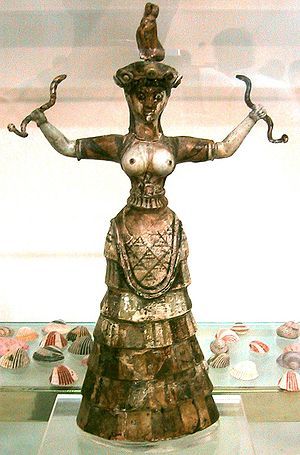
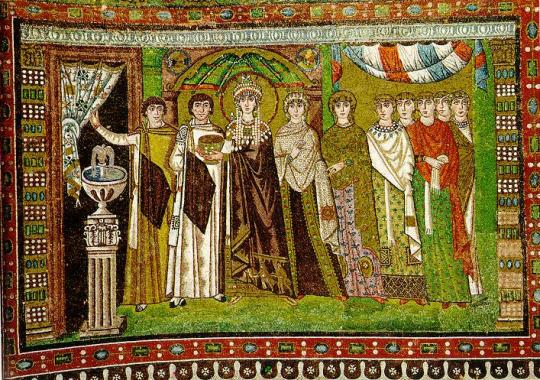


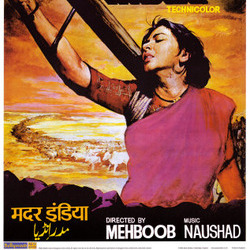



mother
1 'artist' unknown Venus of Willendorf (c28000-25000BCE) limestone http://smarthistory.khanacademy.org/nude-woman-venus-of-willendorf.html
2 artist unknown snake goddess, Minoan Civilization, Crete (c1600 BCE)
3 artists unknown Empress Theodora, mosaic in church of San Vitale, Ravenna, Italy (6th Century) http://smarthistory.khanacademy.org/byzantine-justinian.html
4 Ana Mendieta (1948-85) Cuba/ USA Silueta search at http://www.moca.org
5 Piero della Francesca (1415-92) Madonna of Mercy, detail (c1460) oil and tempera on panel
6 poster from Mehboob Khan's 1957 film Mother India http://www.youtube.com/watch?v=yNFPjvT5PJM http://www.youtube.com/watch?v=JzJHnADcpa8
7 Cindy Sherman Untitled (1989)
8 Maïmouna Patrizia Guerresi () As a photographer, sculptor, and installation artist, ‘Maïmouna’ Patrizia Guerresi reveals unique and authentic sensibilities in her narration of the beauty and subtleties of racial diversity and multiculturalism. Over an established career, she has developed her own symbolism, which combines cosmological and ancestral traditions belonging to various European, African, and Asian cultures. Her personal commitment to Baifall Sufism has led her to produce an aesthetic that is able to bridge time, space and civilisations, as well as figuration and abstraction.
The human body is seen as the nucleus and temple of the soul, a place that houses a delicate, higher awareness; the very conduit for encompassing natural and cosmic forces. More about mysticism than any singular religion, her work is visionary in that it restores those elusive qualities of sacredness and unity in our frequently dehumanising and fragmented contemporary visual world. Her classic iconographic style explores the universality of human experience and reclaims the often hidden nurturing powers of feminine energy. Presented as a kind of free flowing epic, the viewer is left to read the significance of her imagery and quietly meditate on its potential to personally engage with its audience. As if her figures were speaking directly to each one of us.
From her earliest experiments with the physicality and archetypal imprinting of the psyche, through to her latest, evermore metaphoric ‘inner constellations’, Maïmouna insists on a cross-cultural discourse and an expansion of the boundaries that normally dictate our individual attitudes. She invites us to see further and to look deeper – past skin colour, preconceptions, and ethnic landscapes – into the wider paradigm of inclusion. She leads us through apparently simple notions of dimensionality into the exquisite, mystical and fragile complexities of life from within. Rosa Maria Falvo,writer and curator, www.chobimela.org
Perspective on the relationship between women and society, with particular reference to those countries in which the role of women is most marginalized. For over twenty years Guerresi’s work has been about empowering women and bringing together individuals and cultures in an appreciation for a context of shared humanity, beyond borders – psychological, cultural, and political. She uses recurrent metaphors such as milk, light, the hijab, trees, and contrasting white on black to create awareness of the vital unifying qualities of the feminine archetype and its special healing potential. Guerresi’s art is uniquely authentic. Her work is inspired by personal experience and cultural contexts that reference universal myths, the sacred realm, and the female condition, all of which are seen as vital expressions of the human form: an essentially spiritual and mystic body. Through photographs and videos of silent, austere, veiled women in domestic scenes and individual poses, her work functions as both metaphor and provocation. Guerresi’s images are delicate narratives with fluid sequencing, as well as rational analyses: women dressed in white, enveloped in chadors, fixed within their own tradition and isolated from and by it in the contemporary world. Her Fatimah image suggests the woman as Mother- Earth supporting us in the original energy cycle of Space-Universe-Infinity. www.maimounaguerresi.com
9 The Cholmondeley Ladies (c1600-10) oil paint on wood 886 x 1723 mm British School 17th century (1600‑1699)
search @ www.tate.org.uk
#mother#earth#venus#figure#figurative#symbolism#representation#mendieta#minoan#mary#della francesca#willendorf#sherman#Guerresi#spiritual#mother india#cholmondeley#snake goddess
11 notes
·
View notes
Text
Son of the Holy Mother or Great Goddess
Merry Christmas, dear friends. It is a wonderful solstice holiday which is underappreciated by the Christian Churches. In the Neolithic period (8000 to 2500 BCE), the agriculturists understood that life grew out of, and was nourished by, the female energies. They understood fertilisation by males so to activate the process of a new life. As best typified by Minoan archeology, society was balanced…
View On WordPress
#birth#Bitya#Christ#Christmas#female suppression#Great Goddess#Holy Mother#Kurgans#Mary#Minoan#Neolithic#scripture#Semites
0 notes
Text
Son of the Holy Mother or Great Goddess
Merry Christmas, dear friends. It is a wonderful solstice holiday which is underappreciated by the Christian Churches. In the Neolithic period (8000 to 2500 BCE), the agriculturists understood that life grew out of, and was nourished by, the female energies. They understood fertilisation by males so to activate the process of a new life. As best typified by Minoan archeology, society was balanced…
View On WordPress
#birth#Bitya#Christ#Christmas#female suppression#Great Goddess#Holy Mother#Kurgans#Mary#Minoan#Neolithic#scripture#Semites
0 notes
Text
A Sacred Moment.
I accept and recognize with love and pride my part in the plan of the Goddess and her creation.
I embrace my pivotal part on a bigger plan.
I recognize my humble role in a community of warriors and healers blessed by her.
I embrace and celebrate proudly her presence in my life and in all my surroundings under all her names, colors, and shapes.
I Am a Warrior of the Goddess, my arrows are made of love, I aim my arrows high into the firmament, and when my arrows miss they form stars in the sky.








#wicca#witchcraft#magick#magic#witches#pagan#wiccan#paganism#pagan spirituality#wiccan witch#witches of tumblr#wiccans of tumblr#Goddess#goddess mother#mother goddess#minoan brotherhood#minoan witch#gay witch#male witch#male witches
1 note
·
View note
Text

Mother 💃🏻🐍👁️🗨️🌿
May’s illustration is simply called ‘Mother’ as the figure depicted is not one specific goddess, but a personification of the primordial maternal deity all Ancient Mediterranean mother goddesses seem to have sprung from🪴
During my trip through Sicily I became fascinated with the origins of the gorgon and what she represented to the ancient people of Sicily and Magna Graeca. I learnt in some cases the gorgon would be depicted in the pose of the Potnia Theron, Mistress of Animals, who much later had associations with many of the female Olympians. This took me down a rabbit hole, reading up on the Scythian snake-legged goddess who sometimes had the form of the gorgonic potnia theron, the Minoan snake goddesses brandishing snakes, and then the chthonic poppy goddesses of the Cyclades who inhabit the border of the living and the dead. There’s even connection to the goddess Cybele or Bona Dea, who similarly encompass that space of overall Mother of the Gods.
From reading about all these divine mothers from all over the Greek world, I wanted to encompass them all together in their origin. I feel a bit conflicted because it is heavily my own interpretation and I don’t want anyone to feel mislead, but I just wanted to capture the vibe of a powerful, intimidating, ancient goddess who has heavy ties to the balance between life and death✨
#tagamemnon#flaroh illustration#greek mythology#illustration#greek myth#sicily#magna grecia#hellenic mythology#hellenic pagan
587 notes
·
View notes
Note
one of my ocs for a game set in the 1890s is Black and Greek, and I noticed on your main that you talked about the issue of people ignoring or flat-out denying the existence of Black people in Greece when designing characters based on Greek myths etc. so I wanted to ask if you had any specific recommended reading about Afro-Greek history. no worries if not, I just thought I’d check :)
You don't know how timely this one is 😅 There's this apparent belief that Black people weren't capable of trade and migration in the ancient world despite the Mediterranean being a major hub of trade for numerous cultures. And despite the continent of Africa being right there. Apparently if you're not a majority you don't exist at all 🤷🏾♀️
It's long past time for the decolonization of the study of the Classics as a whole, and that includes breaking down the orientalism and white supremacy that encourages people to believe that the only people who ever did anything worth objective study were western white people.
youtube
Indeed, persons of colour even appear on ancient Greek coins and were afforded places of honour. Delphus, after whom Delphi was said to have been named, was depicted as an African on some coinage (possibly because his mother was named Melanis – “the dark one”) and African legendary heroes are also depicted on the coinage of Athens, Lesbos and Phocis. In some vase-paintings, Homeric Circe is depicted as African, possibly in order to emphasise her exotic nature, as are some of Theseus’ youthful followers. A number of Africans are depicted on vases and masks, suggesting both close contact and fascination with them as people and at no stage is there any intimation that the African physical type was considered in any way ugly or inferior.
That last one is a HUGE one that composed of all ethnicities in different contexts and locations. So you'll have to do a good amount of scrolling to get the links you want, but it's incredible. Shout out to Barnard's Classics program.
221 notes
·
View notes
Text

Goddess or Priestess
Minoan, 16th century BCE or early 20th century (Late Minoan or modern)
This statuette closely resembles the ceramic and faience examples found in the sanctuary known as the “Pillar Shrine” in the Minoan palace of Knossos on the island of Crete. Many of these objects are identified as priestesses or goddesses and are associated with fertility, painting the picture of a matriarchal Cretan society. However, current research suggests that most of the gold and ivory statuettes were made in the late 19th and early 20th centuries. At that time, the idea of a Mother Goddess (now discredited by scholars) was popular in archaeological circles.
301 notes
·
View notes
Photo
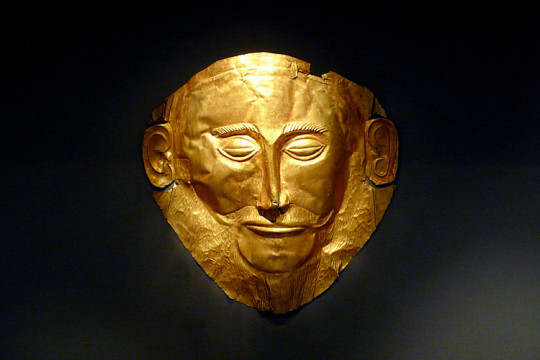
Agamemnon (Person)
Agamemnon was the legendary king of Mycenae and leader of the Greek army in the Trojan War of Homer's Illiad. Agamemnon is a great warrior but also a selfish ruler who famously upset his invincible champion Achilles, a feud that prolonged the war and suffering of his men.
Agamemnon is a hero from Greek mythology but there are no historical records of a Mycenaean king of that name. The Greek city was a prosperous one in the Bronze Age, and there perhaps was a real, albeit much shorter, Greek-led attack on Troy. Both these propositions are supported by archaeological evidence. Unfortunately, though, the famous gold mask found in a shaft grave at Mycenae and widely known as the 'Mask of Agamemnon' is dated up to 400 years before any possible Agamemnon candidate that fits a chronology of the Trojan War.
Agamemnon's Family
Agamemnon was the son of Atreus, or perhaps grandson, in which case his father was Pleisthenes. His mother was Aerope, from Crete which provided a handy link between the Mycenaean civilization of the Greek Peloponnese and the earlier Minoan civilization of Bronze Age Crete. He was married to Clytemnestra with whom he had three daughters. In one version these are Chrysothemis, Laodice and Iphianassa while in other, later versions they are Chrysothemis, Electra and Iphigeneia. Agamemnon was the brother of Menelaos, king of Sparta.
Continue reading...
118 notes
·
View notes
Text

"The prominence of female divinity in Minoan culture might well have reflected the prominence of Minoan women in daily life. In Shang dynasty China, the authority of goddesses such as the Eastern and Western Mothers was echoed to some degree by the authority of women in elite society and even the army. Fu Jing and Fu Hao, wives of King Wu Ding, led men into battle before being honoured in death with monumental tombs containing the victims of human sacrifice, battle axes, knives and arrowheads. In Egypt, many of the images of Hatshepsut were destroyed or defaced after her death when her name was removed from the official list of rulers by her male successors, who sought to claim direct descent from her husband. It is possible that images of powerful Minoan women were subject to similar mistreatment.
While there is no evidence that Minoan women ruled in the same manner as Hatshepsut, or joined battle like the women of Shang China, the sheer number of artworks depicting them centrally placed and on a larger scale than men has prompted some historians to speculate that Minoan society was matriarchal or matrilineal. ‘Neopalatial Crete,’ writes one scholar, ‘presents the best candidate for a matriarchy – if one ever existed.’ There is nothing to say that the position of Minoan women was in any way secondary to that of men.
Minoan women were certainly not confined to the weaving room. Sculptures show them playing lyres, flutes and zithers, sashaying in flounced chevron-patterned skirts and raising their arms in the air in ecstasy. In the ‘Grandstand Fresco’ from Knossos the women are more carefully delineated in paint than the men. Each woman has her own identity, her own style. The women appear to occupy the main rooms of the palace while the men congregate as an anonymous mass beyond. Women depicted seated – a sign of divinity or authority – are often being approached by men or animals. A highly enigmatic fresco at Thera (Santorini), for example, features a woman wearing large hoop earrings, a snake in her hair, and a neck-chain of ducks, sitting on a dais with a griffin beside her while a blue monkey pays her court.
On a gold ring, a female deity, we may presume, is seated beneath a tree, where she receives flowers from two women. A smaller figure of a man with a double-headed axe over his head hovers between them. By depicting the man beneath the axe, and on a smaller scale than the women, the engraver of the ring perhaps hoped to convey that he was a divine vision, almost a thought-bubble, originating in one of the female worshipper’s heads. Trees, as Arthur Evans recognised, were sacred in Minoan culture, and were perhaps believed to be capable of inspiring divine visions in those who honoured them. Such artworks contribute to the picture of Minoan women exerting considerable religious authority in the palace complexes and society more widely.
Minoan women also played a crucial role in ritual. The early Minoans sometimes interred their dead twice by exhuming the bones of their family members and resettling them later in jars. The more usual custom, however, was to bury the dead in chamber tombs or stone beehive-shaped ‘tholos’ tombs, clay sarcophagi or, in the case of infants, under the floorboards of the home. The colourful paintings on a rare limestone sarcophagus from Hagia Triada, circa 1400 bc, show three men carrying young animals and a model boat to the deceased, who stands in front of his tomb, ready to receive his provisions for the afterlife. There are also three women present, the first of whom pours a libation into a cauldron placed between two upright axes mounted by birds; the second carries further vessels; the third – darker skinned like the men and thus possibly of lower social status – has a lyre. On the other side of the sarcophagus the women assist in the sacrifice of a bull on an altar. Other wall paintings show women involved in rituals of their own involving blood. A fresco from Akrotiri features a group of women, one of whom sits beside a sunken room or ‘lustral basin’ with a bleeding foot. A tree also bleeds. It is possible that lustral basins were used for purification by women during or after menstruation."
The Missing Thread: A Women's History of the Ancient World, Daisy Dunn
#history#women in history#women's history#historyedit#minoan women#minoan civilization#bronze age#crete#knossos#ancient history#ancient world#powerful women#historical figures
118 notes
·
View notes
Text
Mycenaean Greek
(and examples of lexical evolution to Modern Greek)
Mycenaean Greek is the most ancient attested form of the Greek language (16th to 12th centuries BC). The language is preserved in inscriptions of Linear B, a script first attested on Crete before the 14th century BC. The tablets long remained undeciphered and many languages were suggested for them until Michael Ventris, building on the extensive work of Alice Kober, deciphered the script in 1952. This turn of events has made Greek officially the oldest recorded living language in the world.
What does this mean though? Does it mean that a Modern Greek could speak to a resurrected Mycenaean Greek and have an effortless chat? Well obviously not. But we are talking about the linear evolution of one single language (with its dialects) throughout time that was associated with one ethnic group, without any parallel development of other related languages falling in the same lingual branch whatsoever.
Are we sure it was Greek though? At this point, yes, we are. Linguists have found in Mycenaean Greek a lot of the expected drops and innovations that individualised the Hellenic branch from the mother Proto-Indo-European language (PIE). In other words, it falls right between PIE and Archaic Greek and resembles what Proto-Greek is speculated to have been like. According to Wikipedia, Mycenaean Greek had already undergone all the sound changes particular to the Greek language.
Why was it so hard to decipher Linear B and understand it was just very early Greek? Can an average Greek speaker now read Linear B? No. An average Greek speaker cannot read Linear B unless they take into account and train themselves on certain rules and peculiarities that even took specialized linguists ages to realise and get used to. Here's the catch: Linear B was a script inspired by the Minoan Linear A, both of which were found in the Minoan speaking Crete. (Minoan Linear A inscriptions have yet to be deciphered and we know nothing about them.) The Mycenaeans (or was it initially the Minoans???) made only minimal modifications to produce the Linear B script and used it exclusively for practical purposes, namely for accounting lists and inventories. Linear B however was an ideographic and syllabic script that stemmed from a script that originally was not designed to render the Mycenaean Greek language, and thus it could not do it perfectly. In other words, the script itself does not render the Greek words accurately which is what made it extremely hard even for the linguists to decipher these inscriptions. Due to its limited use for utility and not for prose, poetry or any other form of expression, the Mycenaean Greeks likely did not feel compelled to modify the script heavily into some more appropriate, accurate form to cover the language's needs.
Examples of the script's limitations:
I won't mention them all but just to give you an idea that will help you then read the words more easily:
In the syllabic script Linear B, all syllable symbols starting with a consonant obligatorily have a vowel following - they are all open sylllables without exception. Linear B can NOT render two consonants in a row which is a huge handicap because Greek absolutely has consonants occuring in a row. So, in many cases below, you will see that the vowel in the script is actually fake, it did not exist in the actual language, and I might use a strikethrough to help you out with this.
For the same reason, when there are consonants together, at least one of them is often casually skipped in Linear B!
There were no separate symbols for ρ (r) and λ (l). As a result, all r and l sounds are rendered with the r symbol.
Exactly because many Greek words end in σ, ς (sigma), ν (ni), ρ (rho) but in Linear B consonants must absolutely be followed by a vowel, a lot of time the last letter of the words is skipped in the script!
Voiced, voiceless and aspirate consonants all use the same symbols, for example we will see that ka, ha, gha, ga all are written as "ka". Pa, va, fa (pha), all are written as "pa". Te, the are written as "te".
There are numerous other limitations but also elements featured that were later dropped from the Greek language, i.e the semivowels, j, w, the digamma, the labialized velar consonants [ɡʷ, kʷ, kʷʰ], written ⟨q⟩, which are sometimes successfully represented with Linear B. However, that's too advanced for this post. I only gave some very basic, easy guidelines to help you imagine in your mind what the word probably sounded like and how it relates to later stages of Greek, and modern as is the case here. That's why I am also using simpler examples and more preserved vocabulary and no words which include a lot of these early elements which were later dropped or whose decoding is still unclear.
Mycenaean Linear B to Modern Greek vocabulary examples:
a-ke-ro = άγγελος (ágelos, angel. Notice how the ke symbol is representing ge, ro representing lo and the missing ending letter. So keep this in mind and make the needed modifications in your mind with the following examples. Also, angel actually means "messenger", "announcer". In the Christian context, it means "messenger from God", like angels are believed to be. So, that's why it exists in Mycenaean Greek and not because Greeks invented Christianity 15 centuries before Jesus was born XD )
a-ki-ri-ja = άγρια (ághria, wild, plural neuter. Note the strikethrough for the nonexistent vowel)
a-ko-ro = αγρός (aghrós, field)
a-ko-so-ne = άξονες (áksones, axes)
a-na-mo-to = ανάρμοστοι (anármostoi, inappropriate, plural masculine. Note the skipped consonants in the script)
a-ne-mo = ανέμων (anémon, of the winds)
a-ne-ta = άνετα (áneta, comfortable, plural neuter, an 100% here, well done Linear B!)
a-po-te-ra = αμφότερες (amphóteres, or amphóterae in more Archaic Greek, both, plural feminine)
a-pu = από (apó, from)
a-re-ka-sa-da-ra = Αλεξάνδρα (Alexandra)
de-de-me-no = (δε)δεμένο (ðeðeméno, tied, neuter, the double de- is considered too old school, archaic now)
do-ra = δώρα (ðóra, gifts)
do-ro-me-u = δρομεύς (ðroméfs, dromeús in more Archaic Greek, runner)
do-se = δώσει (ðósei, to give, third person singular, subjunctive)
e-ko-me-no = ερχόμενος (erkhómenos, coming, masculine)
e-mi-to = έμμισθο (émmistho, salaried, neuter)
e-ne-ka = ένεκα (éneka, an 100%, thanks to, thanks for)
e-re-mo = έρημος (érimos, could be pronounced éremos in more Archaic Greek, desert)
e-re-u-te-ro-se = ελευθέρωσε (elefthérose, liberated/freed, simple past, third person)
e-ru-to-ro = ερυθρός (erythrós, red, masculine)
e-u-ko-me-no = ευχόμενος (efkhómenos or eukhómenos in more Archaic Greek, wishing, masculine)
qe = και (ke, and)
qi-si-pe-e = ξίφη (xíphi, swords)
i-je-re-ja = ιέρεια (iéreia, priestess)
ka-ko-de-ta = χαλκόδετα (και όχι κακόδετα!) (khalkóðeta, bound with bronze, plural neuter)
ke-ka-u-me-no = κεκαυμένος (kekafménos, kekauménos in more Archaic Greek, burnt, masculine)
ke-ra-me-u = κεραμεύς (keraméfs, kerameús in more Archaic Greek, potter)
ki-to = χιτών (khitón, chiton)
ko-ri-to = Κόρινθος (kórinthos, Corinth)
ku-mi-no = κύμινο (kýmino, cumin)
ku-pa-ri-se-ja = κυπαρίσσια (kyparíssia, cypress trees)
ku-ru-so = χρυσός (khrysós, gold)
ma-te-re = μητέρα (mitéra, mother)
me-ri = μέλι (méli, honey)
me-ta = μετά (metá, after / post)
o-ri-ko = ολίγος (olíghos, little amount, masculine)
pa-ma-ko = φάρμακο (phármako, medicine)
pa-te = πάντες (pántes, everybody / all)
pe-di-ra = πέδιλα (péðila, sandals)
pe-ko-to = πλεκτό (plektó, woven, neuter)
pe-ru-si-ni-wo = περυσινό / περσινό (perysinó or persinó, last year's, neuter)
po-me-ne = ποιμένες (poiménes, shepherds)
po-ro-te-u = Πρωτεύς (Proteus)
po-ru-po-de = πολύποδες (polýpoðes, multi-legged, plural)
ra-pte = ράπτες (ráptes, tailors)
ri-me-ne = λιμένες (liménes, ports)
ta-ta-mo = σταθμός (stathmós, station)
te-o-do-ra = Θεοδώρα (Theodora)
to-ra-ke = θώρακες (thórakes, breastplates)
u-po = υπό (ypó, under)
wi-de = είδε (íðe, saw, simple past, third person singular)
By the way it's killing me that I expected the first words to be decoded in an early civilisation would be stuff like sun, moon, animal, water but we got shit like inappropriate, salaried and station XD
Sources:
gistor.gr
Greek language | Wikipedia
Mycenaean Greek | Wikipedia
Linear B | Wikipedia
John Angelopoulos


Image source
#greece#history#languages#linguistics#greek#greek language#langblr#mycenaean greek#modern greek#greek culture#language stuff#vocabulary#linear b#mycenaean civilization
74 notes
·
View notes
Text
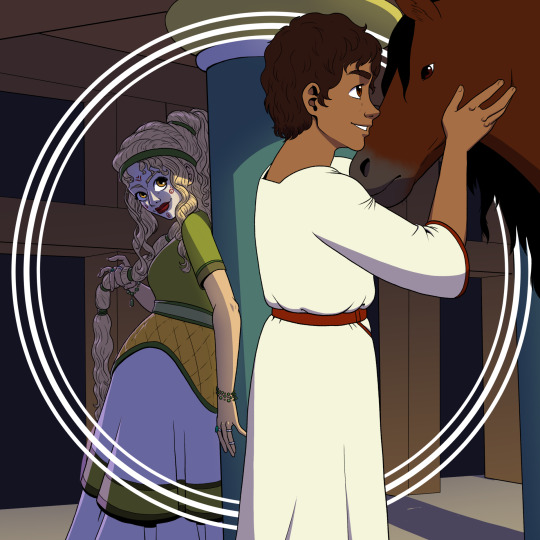
Classicstober Day 18: Phaedra (𐀙𐀂𐀉𐀨)
Phaedra was Ariadne's sister and married Theseus to become Queen of Athens (that must have been a WILD Christmas dinner). Things were good until Theseus' son by the Amazon queen dropped by for a visit. His name was Hippolytus (𐀂𐀢𐀬𐀵)…
Phaedra's story isn't quite as well known as many others in greek mythology, outside of a few tragedies and operas. The nature of the beast for most of these stories is that there are a couple of versions and no one can say which one is the 'real' one, but Phaedra's story, depending on the version you go by, can have wildly different vibes.
As I mentioned, she was Ariadne's sister. In some versions, when Ariadne helped Theseus defeat the Minotaur and escape, Phaedra was with her and part of Theseus' crew when he decided to abandon Ariadne on Naxos, eventually becoming his wife in Athens. In others, Phaedra is ignorant of the role Ariadne played in Theseus' victory and is instead sent to Athens to marry him for a political alliance. The implications of both versions are fascinating from a story-telling perspective. If Phaedra left with Theseus, just how complicit was she in leaving Ariadne behind? If their marriage was purely political, what did she think of the man who had just abandoned her sister? In the end, though, the important part (story wise) is that she marries Theseus and becomes Queen of Athens.
I depicted Phaedra here in her full queenly raiment. Yes, Athens was a purely Mycenaean settlement at this time, but the Mycenaean woman's fashion borrowed LOTS from the Minoan and considering where Phaedra was born she deserved a more Minoan look. That's why she has that quilted-looking over-garment on her dress. I made her palette green to represent her role as queen of Athens, and since Athena is the goddess of olive trees it made sense to me to lean into it. She is also blonde and amber-eyed to show her connection to Helios through her mother, Pasiphaë.
The architecture here is based on Minoan buildings. I imagine that inside the Cyclopean walls of Mycenaean Athens they could afford to make things more royal and less military-pragmatism. Athens is known for being a center of intellectualism in the ancient world (an image they painted themselves with), but even though this scene is set many centuries before the height of Classical Athens' power I decided to lean into that here too.
As for Hippolytus… the sources we have for the ancient Amazons are vanishingly rare. Most scholarship has focused on the Phrygians during the Classical Period, and I was able to find precious little reference for the Bronze Age Phrygians that might represent the historical Amazons. I did find one reconstructed garment, and even though it was very plain (and probably mean for a woman) I decided to put Hippolytus in it anyway. The Amazons were practical warriors, so I doubt that, as a child, Hippolytus would have had any other clothes than what his mother had. I also decided that he should be tall, taller than Theseus, as the Amazons were said to stand taller than normal men.
I could go into more details on the very disastrous story between Hippolytus, Phaedra, and Theseus, but I think it falls outside the purview of this piece. It is a fascinating, compelling story, though, so if you have made it this far into my ramble then I recommend checking it out.
#classicstober#classicstober23#classicstober2023#phaedra#hippolytus#greek mythology#ancient greek mythology#greek myth art#mycenaean#linear b#tagamemnon#amazons
167 notes
·
View notes
Text

Queen Pasiphae slept with a bull sent by Zeus, and gave birth to Minotaur, a creature half man – half bull. King Minos was embarrassed, but did not want to kill the Minotaur, so he hid the monster in the Labyrinth constructed by Daedalus at the Minoan Palace of Knossos.
According to the myth, Minos was imprisoning his enemies in the Labyrinth so that the Minotaur could eat them. The labyrinth was such a complicated construction that no one could ever find the way out alive.
Son of Minos, Androgeus, went to Athens to participate to the Panathenaic Games, but he was killed during the Marathon by the bull that impregnated his mother Pasiphae. Minos was infuriated, and demanded Aegeus the king of Athens to send seven men and women every year to the Minotaur to advert the plague caused by the death of Androgeus.
The third year, Theseus, son of Aegeus decided to be one of the seven young men that would go to Crete, in order to kill the Minotaur and end the human sacrifices to the monster. King Aegeus tried to make him change his mind but Theseus was determined to slay the Minotaur.
Theseus announced to King Minos that he was going to kill the Monster, but Minos knew that even if he did manage to kill the Minotaur, Theseus would never be able to exit the Labyrinth.
Theseus met Princess Ariadne, daughter of King Minos, who fell madly in love with him and decided to help Theseus. She gave him a thread and told him to unravel it as he would penetrate deeper and deeper into the Labyrinth, so that he knows the way out when he kills the monster.
Theseus followed her suggestion and entered the labyrinth with the thread. Theseus managed to kill the Minotaur and save the Athenians, and with Ariadne’s thread he managed to retrace his way out.
want to own a bunch of art like this? Then Please support my upcoming KICKSTARTER book in October! heres the LINK:
#pagan#hellenism#greek mythology#tagamemnon#mythology tag#percyjackson#dark academia#greek#greekmyths#classical literature#percy jackon and the olympians#pjo#homer#iliad#classics#mythologyart#art#artists on tumblr#odyssey#literature#ancientworld#ancienthistory#ancient civilizations#ancientgreece#olympians#greekgods#zeus#hesiod
185 notes
·
View notes
Text
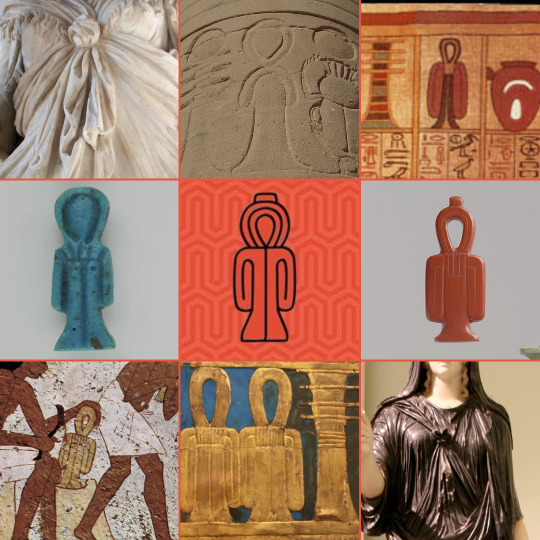
Knot of Isis
This ancient egyptian symbol is called Tjet or Knot of Isis and it's a sign usually connected with the power of the goddess Isis/Aset. Isis is one of the main deity of the egyptian pantheon, sister/wife of Osiris, goddess of magic and wisdom, goddess of kingship and protectress of the kingdom. She was seen as a universal mother goddess connected with beauty, love and fertility. In the Book of the Dead the tjet sign was addressed with the words "Blood of Isis" symbolizing the lifegiver power of blood, especially connected with the menstrual blood where the power of the goddess lies.
This sign resembles the ankh, except that the transverse arms are folded downwards, and resembles a knot of cloth and may have originally been a bandage used to absorb menstrual blood. Others suggest it represents the female reproductive organs and represents Isis in her role as the universal mother. Knots were commonly used in ancient egyptian religion as magical amulets and spell crafting. Large knot in a mantle were worn by Egyptian women from the Late Period onward and we tend to see the Knot of Isis tied into clothing during the Greco-Roman period.
The tyet can be compared with the Minoan sacral knot, a symbol of a knot with a projecting loop found in Knossos, Crete and with the Knot of Inanna.
The tjet was usually placed in tombs and was made with red semi-precious stone like jaspers. The blood of Isis was often combined with the djed-pillar especially in the decoration of temple ,walls, beds and sarcophagi. The djed is a pillar-like symbol associated with the god Osiris and it is commonly understood to represent his spine. When combined the two symbols alluded, via Isis and Osiris, to the unity of opposing world forces and with that to the unconquerable nature of life.
The tjet represents the female generative power of the goddess in which the magical source of isis lies and thus represents an ancient and very powerful symbol of protection and power.
#knot of isis#witchcraft#witchblr#witches of tumblr#tjet#Aset#isis goddess#blood of isis#mother goddess#kemetic paganism#egyptian gods#divine feminine#sacred symbols#esoteric#occultism#ancient symbols
89 notes
·
View notes
Photo
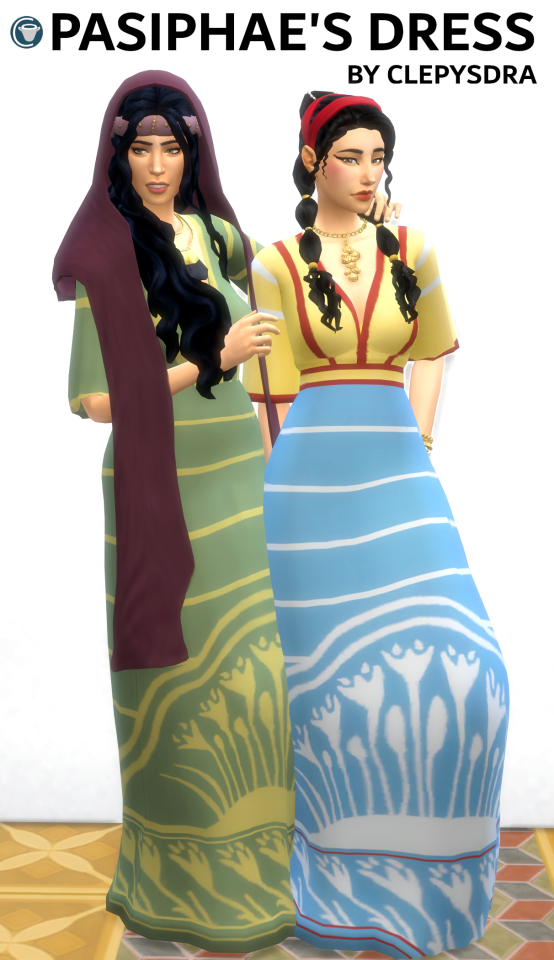
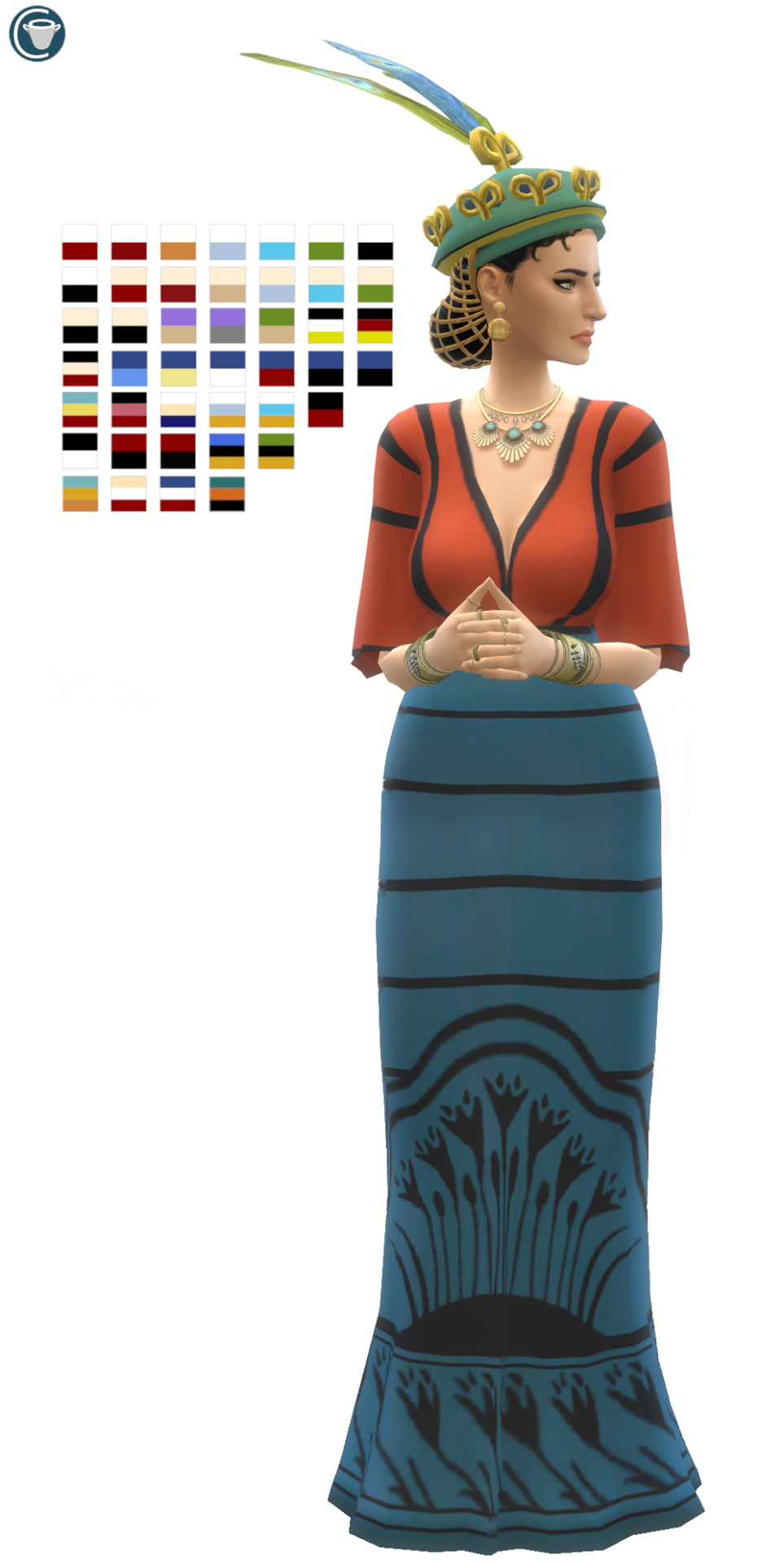
Pasiphae’s Dress
Named after the mythical queen of Minoan Crete. Pasiphae was the wife of King Minos and the mother of the minotaur, Asterion. According to some traditions, she was a goddess of the moon and sorcery.
The dress is based off a ceramic vessel in the shape of a woman’s dress found at the site of Knossos. The skirt depicts crocus flowers near its base.
Prayers for Anna Apostolaki (Άννα Αποστολάκη), who was the first Greek woman to pursue a professional career in archeology. In 1926, she oversaw the reconstruction of ancient Minoan costumes as part of a three day festival held at the Panathenaic Stadium, among which included this beautiful dress.
Long dress category
43 swatches
Base game compatible
Feminine
DRESS DOWNLOAD - Dropbox (no ads)
#my cc#my cas cc#s4cc#ts4cc#crete#cretan#greek#greece#minoan#pasiphae#phaedra#mythology#mythos#history#ancient history#bronze age#mycenaean#mycenae#queen#goddess
258 notes
·
View notes
Text

Wip Lineart of "Bull of Pasiphae", a fluff retelling where the minotaur Asterion is not thrown into the labyrinth.
Minos passes away after upsetting Poseidon a second time, leaving Pasiphae to rule Crete. Asterion grows alongside his siblings (and becomes, ironically, a mama's boy) and receives his education, as well as battle training. When Theseus inevitably arrives in Crete, he's surprised to see there is no beast staring back at him, but a man with the most unusual attributes. The two still duel, in a less lethal way, and due to his training Asterion is actually be able to overpower the still young hero.
His looks are based on the representations of Minoan men seen at Knossos (Minoan men had the best hairstyle of all of history, so I wasn't going to pass the opportunity). Raised mostly by his mother and her maids, as well as spending most of his time with his sister Ariadne, led me to attempt to balance his predominantly masculine physique with a softer feminine touch.
#asterion#bull of minos#minotaur#asterius#greek mythology#art#lineart#villain.jpeg#character design#wip#artists on tumblr
56 notes
·
View notes